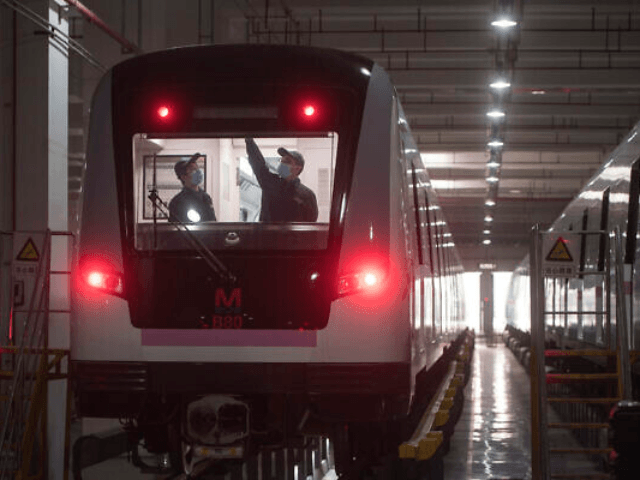Wuhan, the city of 11 million people where the Chinese coronavirus originated, reopened much of its public transport this weekend, including its subway system, despite widespread reports that the Communist Party is hiding the continued spread of the virus there.
Medical experts have traced the first case of Chinese coronavirus back to November 17, 2019, in Wuhan – despite unsubstantiated claims by Communist Party officials that the virus was developed in a U.S. Army laboratory as a biological weapon.
Beijing stopped counting “mild” coronavirus cases towards the official tally of infected people in February and declared a month later that the outbreak had ended. Government officials never explained how they were defining a “mild” case. Most of the world’s affected nations are struggling with testing enough people to catch most coronavirus cases, as many people can be asymptomatic carriers. China’s decision not to count “mild” cases suggests that the Communist Party was not including confirmed carriers in its official statistics, calling into question the use of a testing kit on those people.
Multiple reports citing the number of urns handed out to families at Wuhan’s funeral homes this weekend suggest that the true death toll in the city is over ten times higher than Beijing’s claim.
China’s state-run Xinhua News Agency nonetheless triumphantly declared that the Party had reopened the Wuhan subway system on Saturday, an invitation to locals to return to relative normalcy. To ensure an appearance of safety, the subway system now has equipped a scanner that checks the identity and body temperature of anyone trying to board a train, checking to see if their medical records show any history of having been diagnosed with Chinese coronavirus recently or if their current temperatures may indicate a new infection.
“Inside the subway carriages, there are yellow signs that ask passengers to sit with an empty seat between two of them and security guards who tell people to wear masks during the whole of their trips, not to assemble and scan trip-tracking codes when getting off the subway,” Xinhua reported. “The trip tracking is designed to aid the epidemic prevention and control work. To reduce potential cross-infection, the subway carriages will also be disinfected partly every day and entirely every five days.”
According to Xinhua, 12,000 people in Hubei province, where Wuhan is located, used the public transit trains on Saturday alone, “greeted by applauses and flowers at the station.” That day, Beijing claimed it had identified only 54 coronavirus cases nationwide.
The Hong Kong broadcaster RTHK reported this weekend that many of the trains entering Wuhan “had been fully booked days in advance.” Many of those returning are likely Wuhan residents – Mayor Zhao Xianwang said in January that 5 million people had left the city before he imposed a total lockdown to prevent the virus from spreading nationwide (the lockdown failed).
A day after the trains began returning to Wuhan, on Sunday, the Communist Party held a public mass celebration, a symbol to the world that Wuhan was once again open for business. Radio Free Asia’s (RFA) Chinese language service published a video of people dressed in communist red outfits and sanitary masks dancing and waving Chinese flags in Wuhan, proclaiming the victory of the Communist Party over the virus.
【武汉雷神山「庆功」仪式】【网民神回应:「只有火化是真的!」】
周日(3月29号),中共在武汉雷神山举行了庆功仪式。摄影机三脚架专业设备到位。有网民这样回应有关仪式:「表演式救灾,表演式感恩,表演式送行,表演式新闻,表演式治疗,只有火化是真的!」
网络视频#新冠肺炎#武汉#雷神山 pic.twitter.com/OVWPuoAu8R— 自由亚洲电台 (@RFA_Chinese) March 30, 2020
The celebrations occurred shortly after a massive riot featuring thousands of people broke out elsewhere in Hubei province, on the border with Jiangxi. On Friday, the Chinese government ordered the border between the two states opened. According to various reports, Jiangxi police did not trust that Hubei’s coronavirus outbreak was over and refused to let Hubei people into their state, setting off a melee featuring police officers from both states. The officers faced off alongside civilians overturning police cars and beating officers over the head with riot shields.
The week before Wuhan’s grand re-opening, and the Hubei border riot, several media reports citing people trapped in the city indicated that coronavirus cases were continuing to soar, but Communist Party officials had simply ceased counting them. RTHK, the Hong Kong outlet, cited Wuhan residents to concluded that the end of the outbreak there was a myth.
Locals “say patients are being turned away from hospitals without testing to back the official data, which one person described as a ‘not medical, but political treatment,’” RTHK asserted.
RFA similarly cited residents in Wuhan who warned that every resident of Hubei had “just been left to live or die without any help,” and the survival rate was “basically down to a person’s immune system.”
Videos circulating on social media of Wuhan hospitals appeared to show staff rejecting residents trying to receive care for the flu-like symptoms commonly caused by the Chinese coronavirus – incidents that echo the testimonies in the other reports.
Behind the scenes of #China's "zero case" act, #Hospitals are refusing to treat potential #COVID19 victims to keep their new cases #'s low.
Never trust the #CCP. #CommunismKills.pic.twitter.com/l7Kx8Prswl
— Prof. Steve Hanke (@steve_hanke) March 26, 2020
On Sunday, the Epoch Times also published a disturbing compilation of videos of Wuhan residents clearly wandering the streets in various degrees of illness. One video, allegedly shot right before Beijing claimed Hubei province had stopped finding any coronavirus cases, showed a man collapsing on the street unconscious in broad daylight.
A study published in March found that, had Chinese officials followed guidelines posted online by Wuhan doctors in December and January – which the Communist Party censored before detaining the doctors in question – the country could have prevented as many as 95 percent of the world’s coronavirus cases.

COMMENTS
Please let us know if you're having issues with commenting.